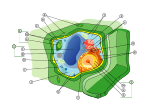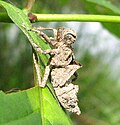Biogenic silica (bSi), also referred to as opal, biogenic opal, or amorphous opaline silica, forms one of the most widespread biogenic minerals. For example...
21 KB (2,635 words) - 00:24, 17 October 2023
Biomineralization (redirect from Biogenic minerals)
model of biogenic silica, Lobel et al. (1996) identified by biochemical modeling a low-energy reaction pathway for nucleation and growth of silica. The combination...
100 KB (10,352 words) - 00:23, 15 November 2024
The silica cycle is the biogeochemical cycle in which biogenic silica is transported between the Earth's systems. Silicon is considered a bioessential...
38 KB (4,252 words) - 18:59, 4 November 2024
specifically N-acetylglucosamine. diatoms have a unique cell wall composed of biogenic silica. A plant cell wall was first observed and named (simply as a "wall")...
43 KB (4,765 words) - 05:01, 2 November 2024
Silicate (redirect from Silica polymer)
six-coordinated octahedral geometry in the mineral stishovite, a dense polymorph of silica found in the lower mantle of the Earth and also formed by shock during meteorite...
11 KB (1,234 words) - 00:33, 15 November 2024
Diatom (section Silica cycle)
and dissolution of biogenic silica in the ocean: Revised global estimates, comparison with regional data and relationship to biogenic sedimentation". Global...
148 KB (15,312 words) - 18:17, 21 November 2024
ocean waters, but still remains low enough that the reaction to form biogenic opal silica remains thermodynamically unfavorable. Despite the unfavorable conditions...
25 KB (3,108 words) - 12:53, 6 June 2024
The Tournaisian limestone may contain up to 25–30 wt. % of reactive biogenic silica originating from the spicules of siliceous sponges deposited with calcium...
78 KB (9,299 words) - 13:47, 14 October 2024
Reverse weathering (section The silica cycle)
the formation of authigenic clay minerals from the reaction of 1) biogenic silica with aqueous cations or cation-bearing oxides or 2) cation poor precursor...
22 KB (2,580 words) - 18:14, 29 September 2024
radiolaria, and siliceous sponges use biogenic silica as a structural material for their skeletons. Some plants accumulate silica in their tissues and require...
87 KB (10,733 words) - 02:11, 12 November 2024
Silicification (section Sources of silica)
presence of biogenic silica in various species creates a large-scale marine silica cycle that circulates silica through the ocean. Silica content is therefore...
31 KB (3,436 words) - 12:04, 27 September 2023
Marine biogenic calcification is the production of calcium carbonate by organisms in the global ocean. Marine biogenic calcification is the biologically...
64 KB (7,212 words) - 19:35, 29 September 2024
Orthosilicic acid (redirect from Dissolved silica)
the diatoms. These algae polymerise the silicic acid to so-called biogenic silica, used to construct their cell walls (called frustules). In the uppermost...
15 KB (1,529 words) - 18:58, 4 November 2024
appetite, or soft tissue calcification.[citation needed] Calcinosis Marine biogenic calcification Monckeberg's arteriosclerosis Pineal gland Bertazzo, Sergio;...
9 KB (925 words) - 23:26, 16 September 2024
typical chemical composition of oven-dried diatomaceous earth is 80–90% silica, with 2–4% alumina (attributed mostly to clay minerals), and 0.5–2% iron...
41 KB (4,382 words) - 05:27, 24 October 2024
responsible for their formation: clastic sedimentary rocks, biochemical (biogenic) sedimentary rocks, chemical sedimentary rocks, and a fourth category for...
63 KB (7,683 words) - 08:39, 25 June 2024
evolved a form of "rebar" endoskeletons made of diffuse meshworks of calcite/silica structural elements called spicules, and echinoderms have a dermal calcite...
11 KB (1,288 words) - 03:42, 22 November 2024
shells of molluscs, brachiopods, and some tube-building polychaete worms. Silica forms the exoskeleton in the microscopic diatoms and radiolaria. One mollusc...
19 KB (2,155 words) - 00:44, 20 November 2024
calcite precipitation calcite sea Great Calcite Belt Silicification biogenic silica siliceous ooze diatomaceous earth Other forms Bone bed Kerogen alginite...
36 KB (3,894 words) - 06:46, 11 August 2024
and siliceous sponges use biogenic silica as a structural material for their skeletons. In more advanced plants, the silica phytoliths (opal phytoliths)...
41 KB (3,843 words) - 18:33, 13 September 2024
calcareous biogenic particles as they settle to the ocean bottom. The final factor is ocean fertility, which controls the amount of biogenic particles...
9 KB (919 words) - 16:42, 2 October 2024
snails. These are not intended for human consumption. As a carbonate-rich biogenic raw material, cuttlebone has potential to be used in the production of...
16 KB (1,651 words) - 05:23, 31 October 2024
defense against predators. Sponge spicules are made of calcium carbonate or silica. Large spicules visible to the naked eye are referred to as megascleres...
71 KB (7,846 words) - 15:12, 2 November 2024
Biogenous sediments Calcareous ooze biogenic calcification calcareous nannoplankton Siliceous ooze biogenic silica silicification diatomaceous earth radiolarite...
10 KB (1,713 words) - 15:11, 16 July 2024
simple one. A drop in solar activity circa 1230 AD as measured by biogenic silica corrected ignition residue (IR-BSi) has been suggested by one study...
154 KB (18,066 words) - 22:57, 15 November 2024
a skeletal structure, made of hard material such as calcium carbonate, silica, chitin or composite materials. As such, it allows the protection of the...
6 KB (656 words) - 09:06, 14 October 2024
communities of invertebrates and fish. Its body is primarily made of biogenic silica (>90%) which is of no nutritional value yet dorid nudibranchs (Diaulula...
5 KB (521 words) - 08:51, 31 October 2024
or external layer of diatoms. The frustule is composed almost purely of silica, made from silicic acid, and is coated with a layer of organic substance...
8 KB (943 words) - 19:49, 4 October 2023
Opal (category Silica polymorphs)
known example of an opal with an insect inclusion Minerals portal Biogenic silica Cacholong – variety of opalPages displaying wikidata descriptions as...
56 KB (5,838 words) - 00:08, 22 November 2024
be either silicate minerals or non-silicate minerals, such as calcite. Silica cement can consist of either quartz or opal minerals. Quartz is the most...
35 KB (3,935 words) - 07:51, 16 November 2024























